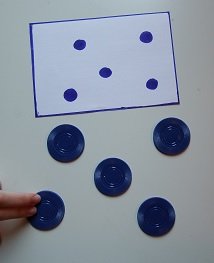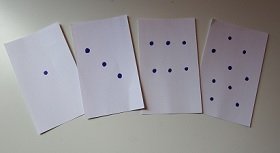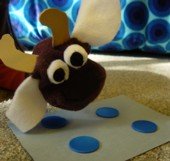Preschool number activities
© 2008 – 2022 Gwen Dewar, Ph.D., all rights reserved

Preschool number activities often involve counting, but only reciting the number words isn't enough.
Children also need to develop "number sense," an intuitive feeling for the actual amount associated with a given number.
Where does number sense come from?
Experiments propose that fifty-fifty half-dozen-calendar month-old infants can tell the deviation between 4 cookies and 8. And 14-month-onetime babies seem to grasp that counting tells us something nigh quantity (Wang and Feigenson 2019).
So that's a commencement. What'south needed — equally kids go older — are easily-on experiences. Inspired by enquiry, the post-obit games encourage kids to think about several key concepts, including
- The one-to-i principle of numerosity (2 sets are equal if and only if their items can exist placed in perfect, i-to-one correspondence)
- The principle of increasing magnitudes (the later number words refer to greater numerosities)
- The one-to-one principle of counting (each detail is to exist counted is counted one time and but one time)
- The stable order principle (number words must exist recited in the aforementioned order)
- The central principle (the last word counted represents the numerosity of the set)
As your child engages in these preschool number activities, keep in mind this advice (from my evidence-based opens in a new windowguide to preschool math lessons):
Start small. It'due south important to suit the game to your child's attention span and developmental level. For beginners, this ways counting tasks that focus on very minor numbers (upwards to 3 or 4).
G eep information technology fun. If it's non playful and fun, it's time to stop.
Exist patient. It takes young children nearly a year to learn how the counting system works.
Six evidence-based preschool number activities
1. Matching sets: Teaching the ane-to-i principle of numerosity
Matching items one-to-one is a surprisingly important mathematical concept. Information technology'south how we prove that two quantities are equal. Two sets comprise the same number of items if the items in each set up can be matched, one-to-one, with no items left over.
Researchers phone call this the "1-to-one principle of numerosity," and y'all tin can assistance kids chief the concept with these simple, preschool number activities.
First, present kids with a small set up of tokens arranged on a table or floor.
Then ask them to create an identical re-create of this set using additional tokens. When finished, brand a count of the items in each fix — the original and the copy.
Second, you can present kids with two sets at in one case.
In this case, make certain each gear up contains the same number of tokens, but arrange the tokens in different spatial patterns. Then take your kid reproduce both of these sets, and do an finish count to ostend that all sets are equal.
It tin take most a yr for a two- or three-twelvemonth-old to really understand how the counting system works, so don't be surprised if younger children have trouble counting across "1-two-3." Help kids with counting if needed, and claiming them to a greater number of tokens as their skills grow.

For another approach to these games, utilise printed cards, each with a movie depicting a set of dots or other minor items.
The kid views the card and creates a matching ready of items using tokens. Yous tin make the cards yourself, or purchase some prepare-made.
What should you utilise for tokens? For children under the age of three years, it's important to choose something that won't pose a choking adventure.
According to the U.S. Consumer Product Safe Commission, a ball-shaped object is unsafe for children under iii years if the detail is smaller than a 1.75″ diameter golf game ball. Other objects are unsafe if they tin can fit within a tube with a diameter of 1.25″ inches. Pieces from your toddler's building cake set up might exercise the chore.
As well, try to stick with plainly-looking tokens and menu symbols.
You might think that little toy frogs or spiders would make counting more fun. But researchers have plant that immature children tend to get distracted by these details.
Kids learn more than from preschool number activities when they manipulate simpler, more abstract items (Petersen and McNeil 2012). Plastic chips — similar those used for poker or bingo — are a good choice for kids aged 3 and upwardly.
2. Sharing at the tea party: Dividing up tokens into equal portions

Hither is another activity to help kids practice one-to-i matching, inspired past the enquiry of Brian Butterworth and his colleagues (2008).
Choose three toy creatures to play the part of party attendees, and have your kid ready the table for them. Then requite your kid a set up of "goodies" (tokens or real edibles) to share with the party guests. The total number of goodies should be a multiple of 3, then your child can distribute all the items every bit and take no leftovers.
If your child makes a mistake and gives one creature also many tokens, y'all can play the office of another brute and mutter.
You tin likewise play the part of tea party host and deliberately make a mistake. Ask for your kid'due south help? Did someone get too many tokens? Or not enough? Have your child ready it.
In one case your child gets the hang of things, try providing him with one token too many and discuss what to do nigh this leftover.
One solution is to divide the remainder into three equal bits. Only your child may come upward with other, not-mathematical solutions, like eating the extra bit himself.
three. Sorting past quantity: Pedagogy the principle of increasing magnitudes

For these preschool number activities, use cards like those described in #1. You tin utilise them in three means.
Game i: Guess the right club.
To play this game, shuffle the cards, and then enquire your child to place them, side past side, in a sequence of increasing magnitude.
For children who haven't yet learned to count, use cards that vary by a substantial amount, e.thousand., three, 6, 10, and 15.
For children with emerging counting skills, use cards that differ by a unmarried dot, and have kids estimate first, then check their answers by counting.
What's the betoken of all this guesswork?
Experiments bear witness that opens in a new windowfifty-fifty babies tin spot differences this large, and practicing these tasks may help children strop their estimation abilities — abilities which are essential for future mathematics achievement.
For example, in a recent report, researchers tested five-twelvemonth-olds with reckoner-based versions of these preschool number activities. The children weren't given enough time to count; they only took a quick look and answered based on their intuitive, visual impression.
Kids who practiced making progressively more difficult discriminations — getting accurate feedback afterward each endeavour — experienced subsequent improvements in their ability to solve issues using symbolic numbers (Wang et al 2016).
Game two: Guess which card has more than dots?
To play this game, select two cards, each displaying a different number of dots, and testify them to your child. Which menu has more dots?
Make sure y'all start with cards that differ by a ratio of at least 2:one. For instance, try 1 vs. 2, 2 vs. iv, and 2 vs. five. Y'all can also endeavor larger numbers, like 6 vs. 12.
Equally your child gets practise with these like shooting fish in a barrel-to-discriminate differences, y'all can present her with increasingly difficult choices (like 6 versus 8; or even 9 versus 10).
For a more playful variant of the game, you can apply tokens instead of cards, and pretend they are something fun, like cakes. Dole out different amounts betwixt y'all and ask, "Who has more?"
Be sure to requite your kid feedback almost the correct answer.
Game three: Big guys eat more.

To play, apply your cards, too as 3 soft animal toys or dolls of varying size — small, medium, and large.
Pretend the toys are political party guests, and the items on the cards treats. And so
- line up the three toys in order of size,
- present your child with 3 cards, each card depicting a different number of dots, and
- enquire your child to give the greatest number of treats to the largest toy, the second-greatest number to the 2nd-largest toy, and the smallest number to the smallest toy.
Tell your child when he responds correctly ("That's right!"), and, if he makes a mistake, guide him to make another attempt ("That'southward non right — attempt again!").
If you adopt, you tin play the game with tokens instead of cards. And once you kid learns to read and understand number symbols, yous tin use cards that brandish but Arabic numerals.
When researchers tested similar preschool number activities, they found that both dot-based and numeral-based games helped children develop better intuitions about quantity. But kids who played the Arabic numeral version of the game experienced greater growth in bones arithmetic skills (Honoré and Noël 2016).

Image of preschool number activities from written report by Honoré and Noël (2016).
4. Spot the goof: Teaching the 1-to-one principle of counting and the principle of cardinality
Here'south another "1-to-i" principle — this time the one-to-i principle of counting. Kids need to larn that each detail in a series is counted once and only in one case. And they as well need to acquire the principle of cardinality, the idea that the last word in our count represents the numerosity of a gear up.
Children larn these ideas through practice. Just they might also larn past correcting others who make mistakes.
In one study, researchers asked preschoolers to sentry–and help–a rather incompetent puppet count a ready of objects (Gelman et al 1986). The puppet would occasionally violate the ane-to-one principle by double-counting (e.g., "i, two, three, three, four…). He too sometimes skipped an object or repeated the wrong cardinal value.

Kids ranging in age from three to 5 were pretty good at detecting these violations. So your child might have fun correcting your ain goofball at home.
What if your kid doesn't detect an error? Correct the goofball yourself. And either way, ask your kid to explicate what went wrong. In some other, like report, researchers found that preschoolers didn't make conceptual progress unless they were asked to explain the puppet's mistakes (Muldoon et al 2007).
For a discussion of how self-explanation can make preschool number activities and other educational experiences more valuable, encounter this Parenting Science opens in a new windowreview of the evidence.
v. 1 less / one more: Helping preschoolers develop intuitions about addition and subtraction
Young children have a long way to get before they are ready to perform basic arithmetic calculations similar "2 +3 = 5," or "7 – 3 = 4." But research suggests we can help pave the way with preschool number activities like these.
Take a puppet or other toy character "bake cakes" (a set of tokens) and enquire your child to count the treats. (You tin can count together if your child needs aid.) Side by side, have the puppet broil 1 more cake and add together information technology to the prepare.
Are there more than cakes or fewer cakes now? Ask your child, and provide him with right feedback afterwards.
Try the same thing with subtraction past having the puppet "eat" a cake. And vary the game by adding or subtracting other minor amounts, like two or three.
Should we look children to come upwards with accurate answers? Non necessary — specially non if they are nether the historic period of three years (Izard et al 2014).
But the experience of predicting and checking is valuable, and fifty-fifty when kids get the precise number wrong, they do a good job coming up with reasonable guesses. When researchers asked 3-, four- and 5-year-olds to perform these tasks, they found that 90% of the guesses were in the right management (Zur and Gelman 2004).
6. The Big Race: Increasing magnitudes and the number line
As your kid begins to master the outset few number words, y'all can also try these research-tested preschool number activities for teaching kids about the number line.
References: Preschool number activities
Butterworth B, Reeve R, and Lloyd D. 2008. Numerical idea with and without words: Evidence from indigenous Australian children. Proceedings of the National Academy of Sciences 105(35): 13179-13184.
Gelman R, Meck Eastward, and Merkin S. 1986. Young children's numerical competence. Cognitive Evolution ane(1): 1-29.
Honoré N and Noël MP. 2016. Improving Preschoolers' Arithmetics through Number Magnitude Grooming: The Impact of Non-Symbolic and Symbolic Training. PLoS One. 11(11):e0166685.
Izard V, Streri A, Spelke ES. 2014. Toward verbal number: immature children use ane-to-one correspondence to measure fix identity but not numerical equality. Cogn Psychol. 72:27-53.
Muldoon KP, Lewis C, Francis B. 2007. Using cardinality to compare quantities: the role of social-cognitive conflict in early numeracy. Developmental Psychology ten(5):694-711.
Park J and Brannon EM. 2013. Training the Approximate Number Organization Improves Math Proficiency. Psychol Sci. 2022 Oct;24(10):2013-9.
Petersen LA and McNeil NM. 2013. Furnishings of Perceptually Rich Manipulatives on Preschoolers' Counting Performance: Established Knowledge Counts. Kid Dev. 84(iii):1020-33.
Wang JJ and Feigenson 2019. Infants recognize counting as numerically relevant. Developmental Scientific discipline 22(6): e12805.
Wang JJ, Odic D, Halberda J, Feigenson L. 2016. opens in a new windowChanging the precision of preschoolers' approximate number system representations changes their symbolic math performance. J Exp Child Psychol. 147:82-99.
Zur O and Gelman R. 2004. Immature children can add and subtract past predicting and checking. Early childhood Research Quarterly 19: 121-137.
Content of "Preschool number activities" last modified 9/19
Image credits for "Preschool number activities"
title epitome of young children with number board past opens in a new windowIvan Radic / flickr
images of supplies for preschool number activities copyright Parenting Science
image of teddy bear tea party past Virginia State Parks
photograph of kid looking at bears by opens in a new windowTom Folio / flickr
epitome of bears and bags courtesy N. Honoré and MP Noël / PLos One 2016
prototype of puppet copyright Parenting Science
braunsteinfinece1954.blogspot.com
Source: https://parentingscience.com/preschool-number-activities/
0 Response to "Preschool number activities"
Post a Comment